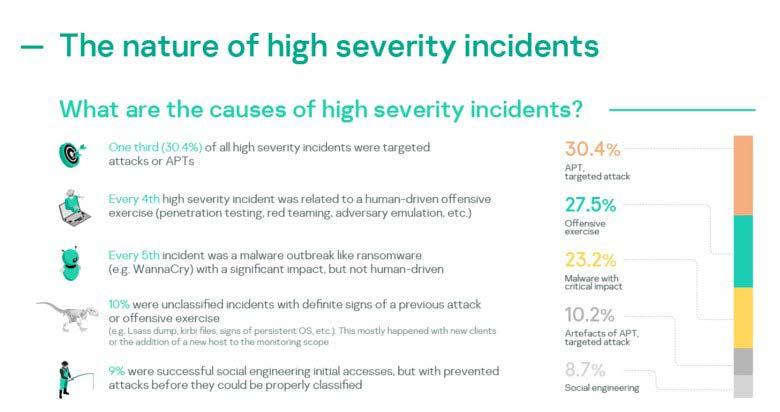
16 minute read
OPINION
REMOTE CODE EXECUTION: THE NEW CYBERSECURITY BATTLEGROUND
SATYA GUPTA, CO-FOUNDER AND CHIEF TECHNOLOGY OFFICER AT VIRSEC, ON WHY THE REMOTE CODE EXECUTION (RCE) IS A DEADLY CYBER-ATTACK WEAPON THAT MUST NEVER BE UNDERESTIMATED.
Satya Gupta
This week, CheckPoint published a new report that chronicled the UAE threat landscape over the past six months. In the report, the company identified that the most common vulnerability exploit type was Remote Code Execution (RCE), which impacted 62% of businesses.
This finding is not at all surprising. From an attacker’s perspective, an RCE vulnerability in a workload – a workload being the infrastructure on which data center software runs- is the gift that keeps on giving, in countless attacks, not only in the UAE but across the globe. Metaphorically speaking, RCE vulnerabilities are like the rocket that will launch
any cyber-attack warhead such as the ransomware (e.g. LockBit, DarkSide, REvil, Sodinokibi, etc. etc.) warhead. Most recently, an RCE vulnerability in an email application was implicated in the highly publicized SolarWinds supply chain attack. RCE vulnerabilities were also the root cause of the Hafnium and Kaseya attacks. Very early and automated protection in response to an RCE attack is essential for effective enterprise protection.
RCE: How it Works
When a craftily constructed payload is delivered to an application with a lurking RCE vulnerability, the application relinquishes execution control to the attacker. The application is said to have reached the “Exploitation” state in the cyber kill chain. Wresting execution control from an application allows the attacker to not only install more tools required to perpetuate the attack but also establish a two-way communication path back to the attacker’s command control center. At this point, the attacker has achieved full keyboard control on the victim. Now the victim workload is totally at the attacker’s mercy and can perform any malicious action of the attacker’s choosing. These actions could include running ransomware, exfiltrating critical data, scraping user credentials, pivoting to other workloads, perform crypto mining activities, join a botnet, etc.
Underestimating the enemy
It is often said that adversaries use the same techniques repeatedly. Assuming threat actors will leverage the same techniques continuously is not only naïve but is also a little selfclaim they work in the application’s runtime, their runtime clock starts after the attack has reached the “Actions on Objectives” state in the kill chain; long after the attacker has achieved keyboard control over the victim workload. These security tools work by tracking how many anomalous activities have occurred over a fixed period of time. They declare the victim is under attack if a pre-defined threshold of anomalous activities is exceeded. A skilled attacker can float under the radar and be able to totally bypass protection offered by conventional security tools. At SolarWinds, the attack continued unabated from September 2019 to Dec 2020 (15 months) before a security vendor published a specific indicator of compromise (IOC).
To achieve true protection against an attack that leverages an RCE vulnerability, the security control must kickstart protection before the attack reaches the “Command Control” stage of the kill chain. An attack that has crossed the Command Control (C2) stage of the kill chain is unstoppable. Irreparable harm is guaranteed to occur.
What the Cybersecurity Future Holds
Continued dependence on security controls that are fueled by threat feeds, even if these tools advertise cool AI/ ML capabilities, is a losing battle. Vulnerabilities will continue to proliferate, and no amount of prior knowledge or threat hunting can keep up. For every hour it takes a bad actor to create new malware, it takes many thousands of hours for cyber defenders to perform static and dynamic analysis on it to extract a foolproof IOC.
FROM AN ATTACKER’S PERSPECTIVE, AN RCE VULNERABILITY IN A WORKLOAD IS THE GIFT THAT KEEPS ON GIVING, IN COUNTLESS ATTACKS, NOT ONLY IN THE UAE, BUT ACROSS THE GLOBE.
serving for classes of cyber security products that leverage signatures and threat feeds. Most adversaries are well funded, skilled, motivated, and highly effective. All they need is early awareness of an RCE vulnerability and an enterprise that is hosting the vulnerable application. Once they are in the enterprise data center, the attack metastasizes in seconds. If the attacker is able to reach the Command and Control state in the kill chain, there is going to be no stopping the adversary.
RCE Vulnerabilities are particularly potent against conventional endpoint, perimeter, and threat hunting security tools. Even though these security tools
Marty Edwards

WHAT ORGANISATIONS CAN DO TO DEFEND IT & OT NETWORKS FROM RAMPANT RANSOMWARE ATTACKS
MARTY EDWARDS, VP, OT AT TENABLE, TELLS ANITA JOSEPH HOW RANSOMWARE ATTACKS ARE BECOMING ALL-PERVASIVE AND HOW TENABLE IS CLOSELY WATCHING THE THREAT ENVIRONMENT, IN ORDER TO HELP ORGANISATIONS PRIORITISE VULNERABILITIES THAT ARE BEING EXPLOITED THE MOST.
Ransomware is taking centre stage today- what’s your take on the ransomware attack scenario in the region?
Ransomware is certainly becoming one of the predominant threats that we face these days. Everybody has talked about and focused on the nation-state aspects of cybersecurity for far too long, and now we see the shift towards highly organised
criminal organisations. I am extremely concerned because I think criminals always go where they can make the most money and critical infrastructure is a very attractive target for them. I think they’re going to continue to pivot and target organisations where they can make the most money.
Is the critical infrastructure of organisations being actually affected by rampant ransomware attacks and what can organisations do if they find themselves the target of a ransomware attack?
Before the convergence of IT & OT networks, all the operational technology – the computers that actually operate your factory or operate your water treatment facility or your power grid or refinery or what have you – were predominantly isolated or air gapped. But that’s no longer the case. For business reasons we’ve interconnected these different networks, and you have to be very concerned with the detection of ransomware or detection of any kind of security threat, no matter what network it’s on.
I would say that if you find ransomware on your network, then it’s almost too late to be testing your backup and restore procedures. You should have a plan and you should anticipate a worst-case scenario, for example that you’re going to be infected with ransomware. So, make sure that you have your backup and recovery plans, plus your disaster recovery plans, in good shape, and regularly test them. I can’t believe how many people take backups of their data, but they never test restoring them. So, the way I describe it to people is that you should treat it no different from anticipating a fire — for example, in your server room. If you have a fire in your server room, and it destroys your computers, how many days does it take your business to get back up and running? Ransomware should be no different, and we should have a plan in place to limit the damage and recover quickly. standalone security product inside your Operational Technology environment, or a standalone security product for vulnerability management, or a standalone security product for active directory security management, and so on. We need to get all that information into the same place, so that it can be analysed to give you a holistic picture of what’s happening from a security standpoint on your networks. These converged networks are complex and they’re connected in ways that many organisations don’t even understand, until we help them through that journey.
And so, I think that you need to partner with a security provider that can give you a broader view. This ransomware threat is not going away. Fortunately, our governments are holding diplomatic discussions on international law enforcement and are trying to do better at holding criminals accountable for their actions. But I think it’s such a lucrative environment right now, that it’s only going to get worse. In fact, we haven’t seen the worst of it yet.
What do you think is the biggest challenge that organisations in the region face in the fight against ransomware. Why does this happen and how does the challenge come about?
It’s complex, and I think that there’s no easy answer. Some organisations do an extremely good job at proactive cyber security measures to try and combat things like ransomware. But then you have other organisations that perhaps haven’t even started with a basic level of security. I wouldn’t want to paint any organisation as being good or bad. Ransomware is evolving in complexity and we are seeing increased instances of Ransomware as a Service – this means you have experts that write the actual code, but then they sell that as a service to some other criminals that may not have the cyber skills, but are more efficient at moving money and targeting organisations, or getting that initial system foothold. So, they’re all working together, and that means they’re bringing the best of the best to the fight. As defenders, we have to counter that with the best of the best, as well.
How does Tenable step in to help fight ransomware in the region?
It’s multifaceted. First and foremost, the majority of ransomware is based on known and existing vulnerabilities. So, if you have a good programme in place to detect where your assets are vulnerable, then you are in the position to prioritise these to fix the highest priority ones first. We do this for you – we watch the threat environment and we help you prioritise which vulnerabilities are being exploited the most. We do that everywhere in your IT network. And in your OT environment, we also have threat detection capabilities. So, we’re actually monitoring all networks and we can tell you if we see threats in any area.
Are businesses doing enough to address the issue? How do you see the whole ransomware ecosystem playing out?
It’s no longer sufficient to just have a
SOPHOS REPORT REVEALS STEALER CAMPAIGN DISGUISED AS PIRATED SOFTWARE
STEALER IS DELIVERED TO TARGETS BUNDLED WITH RANSOMWARE AND OTHER MALICIOUS CONTENT, SAYS SEAN GALLAGHER, SENIOR THREAT RESEARCHER AT SOPHOS.
Sean Gallagher
Sophos, a global leader in next-generation cybersecurity, has published new research, “Trash Panda as a Service: Raccoon Stealer Steals Cookies, Cryptocoins and More,” detailing how a stealer disguised as pirated software grabs cryptocurrencies and information while dropping malicious content, such as cryptominers, on targeted systems.
“With much of daily and professional life now reliant on services delivered through a web browser, the operators behind information-stealing malware are increasingly targeting stored web credentials that provide access to a lot more than they could get by just stealing stored password hashes,” said Sean Gallagher, senior threat researcher at Sophos.
“The campaign we’ve been tracking shows Raccoon Stealer grabbing passwords, cookies, and the ‘autofill’ text for websites, including credit card data and other personally identifying information that may be stored by a

browser. Thanks to a recent ‘clipper’ update that changes the clipboard or destination information for a cryptocurrency transaction, Raccoon Stealer also now targets crypto-wallets, and it can retrieve or load files – such as additional malware – on infected systems. That’s a lot of stuff that cyber criminals can easily monetise for a service that is ‘rented out’ at $75 for a week’s use.”
Raccoon Stealer is usually spread by spam E-mail. However, in the campaign Sophos investigated, it is distributed through droppers that the operators disguised as cracked software installers. These droppers bundle Raccoon Stealer with additional attack tools, including malicious browser extensions, YouTube click-fraud bots, and Djvu/Stop, a ransomware targeted primarily at home users.
The operators behind this Raccoon Stealer campaign also used the Telegram chat service for the first time for command-and-control communications, according to Sophos researchers.
“Information stealers fill an important niche in the cyber crime ecosystem. They offer a quick return on investment and represent an easy and cheap entry point for bigger attacks,” said Gallagher. “Cyber criminals often sell stolen identity credentials on ‘dark’ marketplaces, allowing other attackers, including ransomware operators or Initial Access Brokers, to take advantage of them for their own criminal intentions – such as breaking into a corporate network through a workplace chat service. Or attackers can use credentials for further attacks targeting other users on the same platform. There is a constant demand for stolen user credentials – especially credentials providing access to legitimate services that attackers can use to easily host or spread more malware. Information stealers may look like lower-level threats, but they’re not.”
Sophos recommends that organisations that use online services for workplace chat and collaboration use multi-factor authentication (MFA) to protect employees’ accounts and ensure that all employees have up-to-date malware protection on any computer they access remote work-related services from.
Sophos Intercept X protects users by detecting the actions and behaviors of malware like Raccoon Stealer, including scanning for suspicious activity in memory and protecting against fileless malware.
Sophos advises consumers to install a security solution on the devices that they and their families use for online communications and gaming, such as Sophos Home, to protect everyone from malware and cyberthreats. It is also good security practice to avoid downloading and installing unlicensed software from any source. Always check first to make sure it’s legitimate.


AMIVIZ JOINS HANDS WITH PICUS SECURITY TO ENHANCE THREAT PREPAREDNESS OF PARTNER NETWORK
AmiViz, the Middle East region’s first enterprise B2B marketplace, has announced that it has expanded its portfolio of cyber security solutions by partnering with Picus Security.
Picus Security’s Complete Security Control Validation platform tests and measures the effectiveness of security tools to prevent and detect the latest cyber threats. It also provides vendor-specific mitigation content and insights to address weaknesses and gaps in coverage and visibility.
Due to the rapid speed at which threats evolve, it is vital that all organisations should be able to determine the state of their security posture at any time. By partnering with Picus, AmiViz offers its community of reseller partners and their customers an automated solution to continuously assess the preparedness of network, endpoint, and email controls to safeguard against attacks and breaches. Picus’ rich threat library contains over 10,000 threat samples and attack scenarios, including the most prevalent types of malware and adversarial techniques.
According to AmiViz, security needs to be a board-level conversation. The Picus platform enables security teams to quantify risks, helping business leaders to understand how well prepared their organisation’s controls are to defend critical assets against current and emerging threats.
AmiViz, with its one-of-a-kind enterprise marketplace, offers Picus Security the ability to identify and recruit reseller partners across the Middle East. AmiViz’s Virtual Customer Experience Centre is equipped to help resellers showcase Picus’s technology to clients remotely by providing a unique customer-specific environment in the cloud.
“Keeping up with the latest cyber threats is a huge challenge for all organisations,” says Tim Ager, VP of Sales for EMEA at Picus Security.
“By partnering with AmiViz, we’re delighted to introduce the benefits of an automated and continuous approach to security validation to businesses across the Middle East and demonstrate why the Picus platform stands out from the crowd - offering a comprehensive solution that not only simulates the latest attacks but also helps to improve controls to better defend against them.”
About AmiViz
AmiViz is the first B2B enterprise marketplace focused on the cybersecurity industry in the Middle East, designed specially to serve the interests of enterprise resellers and vendors. Driven by innovation and AI-powered technology, the platform provides a unique collaboration platform through a mobile app on iOS and Android, as well as a webbased platform to enterprise resellers, consultants, system integrators, channel partners and vendors. AmiViz offers its one-of-a-kind consumer-style e-commerce platform with a fusion of human touch, offering products and services that cater to localised market conditions and regulations across the Middle East.
About Picus Security Inc.
Picus Security is a leading Breach and Attack Simulation vendor, enabling organisations to test, measure & improve the effectiveness of their cyber security controls through automated and continuous offensive and defensive security testing. The company has been named by Frost & Sullivan as one of the most innovative players in the BAS market.
ONE IN 10 CYBERSECURITY INCIDENTS IN ORGANISATIONS CONSIDERED SEVERE: KASPERSKY
According to anonymised metadata voluntarily provided by Kaspersky MDR customers, one-in-10 (9%) prevented cybersecurity incidents could cause major disruption or unauthorised access to the customer’s assets. The vast majority of incidents (72%) were of medium severity. This means that if these threats had not been detected by the service, they would have affected the performance of the assets or could lead to single data misuse cases.
Cyber attacks are growing in complexity and employing evasive techniques to avoid detection by security solutions. Detection and prevention of such threats requires seasoned threat hunters who can spot suspicious actions before they cause damage to a company. Kaspersky analyzed anonymised customers’ cases identified via the Kaspersky MDR service in Q4 2020 to see how widespread and severe resolved incidents were.
The research revealed that almost every industry, except mass media and transportation, saw high severity incidents during the analysed period. Most often critical incidents affected organisations from the public sector (41% of all high severity incidents were detected in this industry), IT (15%) and financial (13%) verticals.
Almost a third (30%) of these critical incidents were human-driven targeted attacks. Almost one quarter (23%) of high severity incidents were classified as high impact malware outbreaks, including ransomware. In 9% of cases, cyber criminals gained access to a company’s IT infrastructure using social engineering techniques.
Kaspersky experts also noted that current APTs were typically detected together with artifacts of previous

advanced attacks, suggesting that if an organisation responds to a sophisticated threat, it’s often attacked again, likely by the same actor. Also, in organisations experiencing APTs experts often discovered signs of simulation of adversarial behavior, such as red teaming, or an assessment of a company’s operational security capabilities through a sophisticated attack simulation.
“Our study found that targeted attacks are rather common — more than one quarter (27%) of organisations faced them. The good news is that organisations that are likely to experience such incidents know about this risk and are prepared for them. These organisations employ services that help them assess their defensive capabilities, such as red teaming, as well as seek help from experts who can stop criminals, “ said Gleb Gritsai, Head of Security Services, Kaspersky.
To protect your organisation from APTs and other advanced attacks, Kaspersky recommends the following:
Dedicated services can help against high-profile threats. The Kaspersky Managed Detection and Response service can help identify and stop attacks in their early stages, before the attackers achieve their goals.
Use a dedicated set for effective endpoint protection, threat detection and response products to timely detect and remediate even new and evasive threats. Kaspersky Optimum Framework includes the essential set of endpoint protection empowered with EDR and MDR.
Provide your SOC team with access to the latest threat intelligence and regularly upskill them with professional training.
Provide your staff with basic cybersecurity hygiene training, as many targeted attacks start with phishing or other social engineering techniques.





